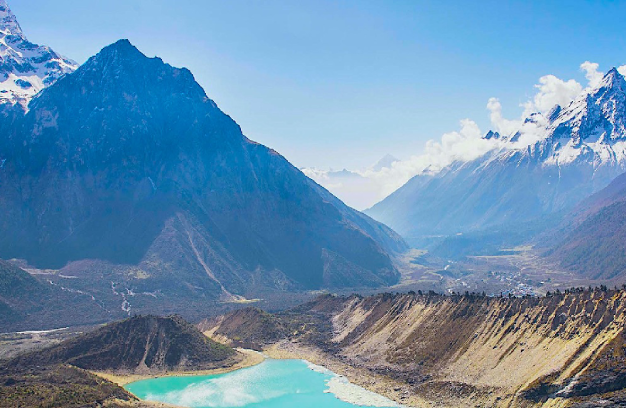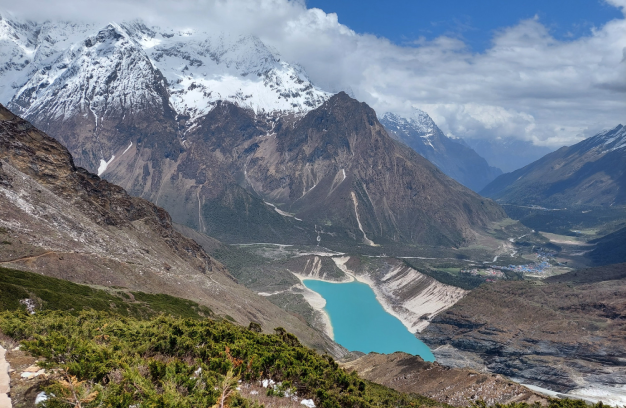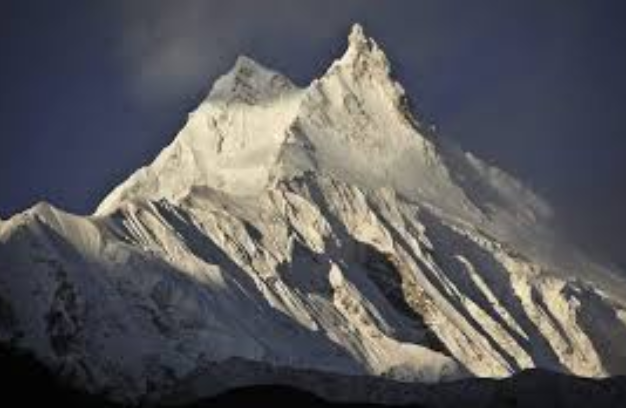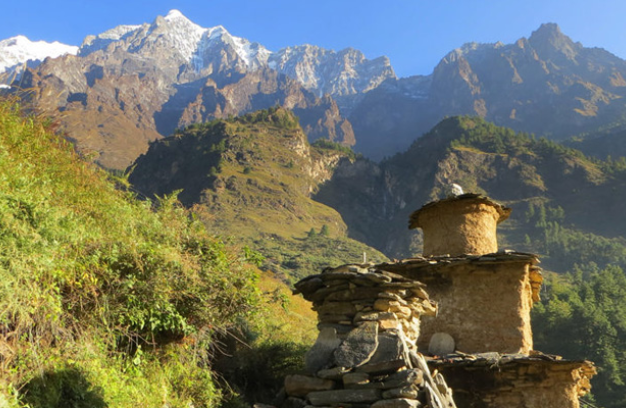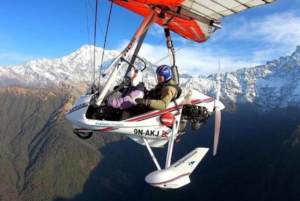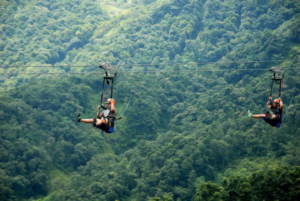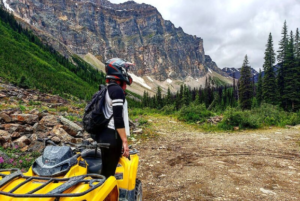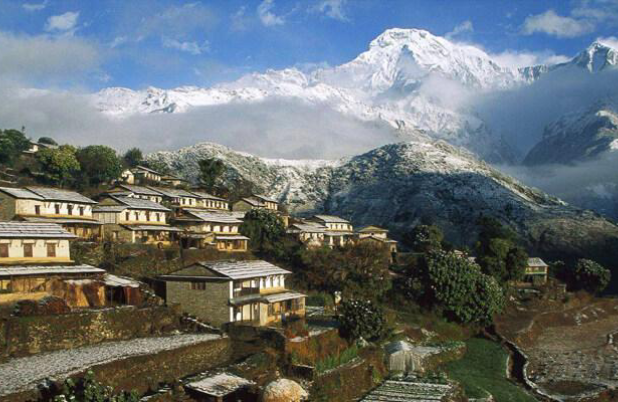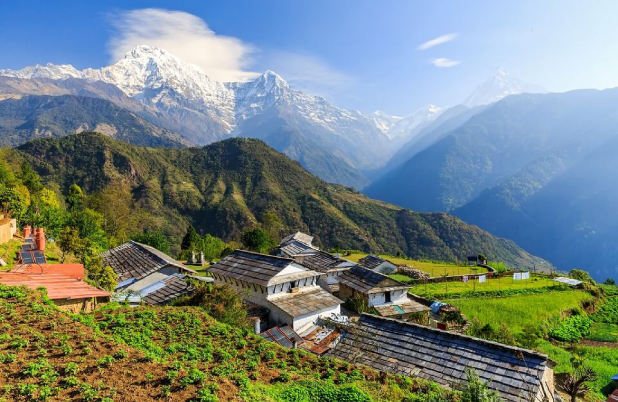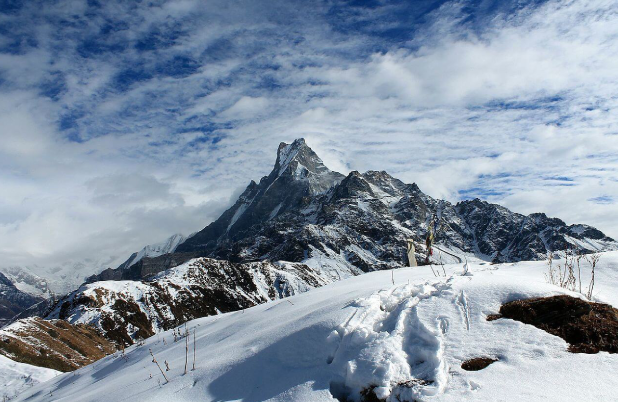Manaslu-Tsum Valley Trek 23D
Overview
Discover the unspoiled and isolated regions of the Manaslu-Tsum Trek, also called the Manaslu Valley Trek, which leads to Tsum Village, Nepal's version of the secret Shangri-La. Tsum Valley, which is bordered to the west by the Annapurna Conservation Area and to the north and east by the Tibetan Plateau, provides a tranquil and immaculate trekking experience.
Included/Excluded
- Accommodations
- Meals: Breakfast, Lunch and Dinner,
- Transportation
- An experienced English-speaking and government-licensed trekking guide
- All necessary paperwork and trekking permits (ACAP, TIMS)
- Pickup
- Any other transportation except included in the section
- Travel and rescue insurance
- Tips for guide(s), porter(s) and driver(s)
Tour Plan
Day 01. Arrival in Kathmandu (1,350 m)
Upon arrival in Kathmandu, we will be greeted by a representative of Sisne Rover who will drop us off at our hotel. We then check-in at the hotel, freshen up and take rest. You can also visit around Thamel (where our hotel will be located) and shop few items that you have missed to bring with you. Overnight in Kathmandu.
Day 02. Kathmandu – Permit Preparation
On your second day in Kathmandu, take rest after a long flight from your home country and after breakfast, you can visit around Thamel (where your hotel will be located) and shop few items that you have missed to bring with you. We can add Kathmandu Valley Sightseeing tour on your request. We can have a tour to UNESCO World heritage sites – Durbar Square, Pashupatinath temple, Swoyambhunath stupa and Bouddhanath stupa. In the afternoon, we will have a meeting with your guide and check the final preparation for the trek.
Meals included: Breakfast
Day 03. Drive from Kathmandu to Machha Khola (900 m): (9-10 Hrs.)
We set off early today and head towards the village of Soti Khola (710m) along the Kathmandu-Pokhara Highway. This drive will take us through small rural towns and grassy terraces. During the drive, we enjoy views of the Nepalese countryside along with the mountain sceneries. After around 7 hours, we will arrive at Soti Khola in the Budhi Gandaki Valley.
After having some rest in Sotikhola, we will take another transport and continue driving to Machhakhola. It is about 3 hours drive. Overnight in Machhakhola in a lodge.
Meals included: Breakfast Lunch Dinner
Day 04. Trek from Machha Khola to Jagat (1,410 m): (6-7 Hrs.)
The narrow trail makes some minor ups and downs and eventually crosses the Thado Khola and reach Khorlabesi. After a few more ascends and descends we come across a small Hot spring in Tatopani. From the hot spring, we climb over another ridge, then cross the Budhi Gandaki on a suspension bridge. At this juncture, we climb on a wide, well-crafted staircase, then across a landslide and over a ridge to Dobhan. Upon crossing a suspension bridge over the Yaru Khola, we climb stone stairs and then descend to the river and again climb more stone stairs to Tharo Bharyang. Crossing the west bank of the Budhi Gandaki, we climb over a ridge, trek along the river and then climb towards the village of Jagat. Overnight in Jagat.
Meals included: Breakfast Lunch Dinner
Day 05. Trek from Jagat to Lokpa (2,040 m): (5-6 Hrs.)
Today, we begin trek by climbing over a rocky ridge to Salleri, and then descend to Sirdibas. The valley widens a bit as the trail continues up to Ghatta Khola. We further continue walking upstream to a long suspension bridge in Philim, a large Gurung village. The trail turns north just above the lowest house in the village and stays on a fairly level as it crosses millet fields to Ekle Bhatti. The route now enters a steep, uninhabited gorge. At this point, we descend to the grassy land slopes, cross the Budhi Gandaki, then trek along the west bank for a while, then cross to the east bank and then back again. Across the Budhi Gandaki is Himalchuli (7,893 m) above steep cliffs. Walk through a largely intact and peaceful temperate forest into Lokpa surrounded by barley fields.
Meals included: Breakfast Lunch Dinner
Day 06. Trek from Lokpa to Chumling (2,360 m): (3-4 Hrs.)
Descend through beautiful forest, crossing two new bridges, circle under a huge bluff on the river then climb steeply on deteriorating exposed stairs. After about 30mins start to traverse north through pines and rhododendrons, still climbing and with very steep slopes. The hidden valley of Tsum stretches enticingly ahead. Eventually descend to a deserted bhatti, Ghumlong (2130m) on the river. The path straight ahead climbs steeply to Ripchet (2470m) in about 1hr; the path to Chumling (2360m) crosses the Siyar Khola on a wooden bridge and up. Make sure we climb up to Chumling and check out the old Gompa, the traditional houses, orchards, clinic and beautiful stone streets. This is Buddhist agriculture, with conical pine needle haystacks among the prayer flags. From here on trails are lined with artistic Chortens and Mani walls made of thousands of stone slabs carved with deities and prayers.
Meals included: Breakfast Lunch Dinner
Day 07. Trek from Chumling to Chhokang-Paro (3,010 m): (3-4 Hrs.)
Cross the suspension bridge just east of the hotel and traverse through rich farming land of maize and potatoes. The houses are classic Tibetan with barricades of firewood on the roof, but without flat roofs as it rains and snows here. Up the valley to the east are superb views of several of the 7,000 m – 7,400 m Ganesh Himal. Cross the Serpu Khola and climb for over 2hrs on well-graded but exposed track to upper Tsum and the joined villages of Chhokang-Paro (3,010 m), stone houses with a few iron roofs nestled under cliffs. The valley opens here into spacious fields of barley, maize, buckwheat and potato. Herds of thar often graze the wild cliffs to the north, coming right down to the fields. If the air is clear Himalchuli (7,893 m) can be seen down valley.
Meals included: Breakfast Lunch Dinner
Day 08. Trek from Chhokang-Paro to Nile (3,381 m): (3-4 Hrs.)
Take time to explore the village and climb north to a retreat where Lama Kongchog died after 26 years of meditation. Thar are often sighted near here. The friendly people speak Tsumba, related to Tibetan, but often little Nepali and are quite unused to visitors.
Head east through small villages and past a local school, climb over a ridge of Chortens and past Lamagaon (3,202 m) through the flat fields, looking across the extensive crops and river to the huge courtyard of the Rachen Gompa (3,240 m) with excellent pilgrim accommodation. This nunnery is the female equivalent of the main Kathmandu Kopan Monastery.
Cross the Shiyar Khola, pass through hamlets of Phurbe (3,251 m) and Pangdun (3,258 m) and pass an unusual round stupa before reaching the larger village of Chhule (3,347 m) through an impressive entrance gate. The children here all wear the Tibetan dressing gown called chubas and there are many yaks. Head upstream to cross the bridge and climb to Nile (3,361 m). Both villages are in traditional style with inclusion of livestock compounds into the houses and sheltered verandahs for drying crops.
Meals included: Breakfast Lunch Dinner
Day 09. Trek from Nile to Mu Gompa (3,700 m): (2 Hrs.)
We leave our rucksack behind and visit Mu Gompa as a day trip, continuing on to Rachen Gompa or Chhokang-Paro, or stay overnight in Mu Gompa and visit the isolated Dhephu Doma nunnery and gompa and even climb above it for great views.
Make up valley on the west bank, enjoying sunrise on the narrowing valley walls and yaks being put to pasture. The final climb up to the large Mu Gompa (3,700 m) is through dry Tibetan country with rows of Chortens and widening mountain vistas. This is a large monastery with over 100 monks and an ancient Gompa visited by David Snellgrove (Himalayan Pilgrimage) in 1956.
Meals included: Breakfast Lunch Dinner
Day 10. Trek from Mu Gompa to Rachen Gompa (3,240 m): (3-4 Hrs.)
Return down valley through Chhule, collect our rucksack if we left it there, and continue down as far as Phurbe. Stay on the east bank of the Siyar Khola and cross flat boulder-covered plains following the power lines to Rachen Gompa (3,240 m), where it is possible to inspect the ancient Gompa if we want and the many young nuns are very friendly. Families in the Tsum usually have at least one family member as either a monk or a nun.
At Rachen Gompa we can stay in comfortable pilgrim rooms, wash clothes and eat dalbhat in shifts with the nuns, enjoying electric light and maybe a solar hot shower.
Meals included: Breakfast Lunch Dinner
Day 11. Trek from Rachen Gompa to Gumba Lungdang (3,200 m): (5-6 Hrs.)
Continue south until a bridge crosses to the west bank and pass again through Chhokang Paro then drop below on the previous trail towards Chumling. After about 2hrs, see a small white Gompa on the left at Gho (2,485 m). Descend on a narrow trail passing the Gompa on our left and drop to a wooden bridge over the Siyar Khola. Cross the bridge to Domje (2,460 m) which has a Tibetan herbal medicine clinic and school but no food or lodging. The track onwards climbs just behind the clinic.
Climb very steeply through pines and rhododendrons until the track starts traversing at a Mani wall with prayer flags. The track is exposed and narrow. Finally, in the pine forest, take a prayer flag marked uphill trail and make a zigzag climb through huge silver pines to reach Gumba Lungdang (3,200 m), perched on a ridge with small cells for the nuns scattered through the beautiful rhododendrons above. This small Gompa with 40 nuns has an intense and engrossing puja from 6.00-7.30pm each night unless the nuns are on holidays or elsewhere, which is for some months each year. There is no lodge or formal camping area but permission may be obtained for a limited number of people to sleep on the Gompa verandah or to camp in the Gompa forecourt and use their kitchen. There is a toilet although we may have to ask for water. The mountain views in all directions are amazing.
Meals included: Breakfast Lunch Dinner
Day 12. Day trip to Ganesh Himal Base Camp (4,200 m): (7-8 Hrs.)
Circle from the Gompa through a white gateway and below the nuns’ housing, between two houses and traverse down and up through two small valleys, then drop right on dusty or muddy zigzags on a shortcut to regain the lower track and continue up valley through the forest. It takes about 4hrs to reach the Ganesh Himal Base Camp (4,200 m). The map shows another base camp on the east side of the glacier, but there appears to be no obvious track between them, so return to Gumba Lungdang in time for the evening puja by retracing our steps.
Meals included: Breakfast Lunch Dinner
Day 13. Trek from Gomba Lungdang to Lokpa (2,240 m): (7-8 Hrs.)
This can be a taxing day, so start early. Descend to Dumje and Cross the Laudang Khola on a new swing bridge between the two lowest houses in Dumje and stay on the south bank of the Siyar Khola. Cross some very deep gorges on new swing bridges to picturesque Ripchet (2470m.) where there is a homestay and we can get lunch. Take time to look around at this perched fertile valley of barley and buckwheat with evocative Chortens in the fields backed by pine forest. Descend on steep loose stairs to the deserted bhatti Ghumlong (2130m) on the river, which we passed through some days ago. Climb again through the pristine temperature forest to Lokpa (2240m), enjoy a comfortable bed in the lodge there and maybe a bucket bath in the toilet or camping toilet.
Meals included: Breakfast Lunch Dinner
Day 14. Trek from Lokpa to Ghap (2,160 m): (4-5 Hrs.)
Continue from Lokpa down the exposed track until the track from Philim comes in from the left. Turn right, cross the Budhi Gandaki on a solid bridge after about 1hr and traverse to a welcome bhakti just around the corner for tea and a last look up the Tsum Valley. Enter a very narrow gorge with loose tracks, up and down, up and down. After about 2hrs, reach Sirdibas (1,860 m) and again in another hour enter Nupri (‘the western mountains’) through bamboo forests to Deng (1,800 m), inhabited by Gurungs who practice Buddhism. Just beyond Deng, re-cross to the east bank and climb to Rana (1,980 m) and pass Bihi Phedi (1,990 m) with the trail up to the stone-carving village of Bihi (2,130 m). Continue in and out of continuous wild canyons and cross the Serang Khola coming from the north and climb steeply again before finally circling into Ghap (2,160 m). The Mani walls here and onwards as far as Bhimthang often display intricate quality carvings of various Buddhas in meditation, incised in the hard local stone by a family of carvers from Bihi.
A side-trip from a bridge below Bihi can take us up to Prok (2,380 m), with an ACAP office and emergency radio and an excursion to Kal Tal (3,685 m; Kalchhuman Lake), then back down to Ghap.
Meals included: Breakfast Lunch Dinner
Day 15. Trek from Ghap to Lho (3,180 m): (5-6 Hrs.)
Enter a beautiful forest of fir and rhododendron with many birds, staying on the south bank, cross north on a wooden bridge with a roaring narrow canyon below then cross back to the south bank on a new swing bridge with grey langurs watching. The main trail now climbs on well-made stairs, but a highly recommended narrow shortcut to the right just after the bridge and along the riverbank is far quicker and through superb pine forest. The architecture characteristic of upper Nupri starts here; several houses gathered together about a common courtyard and livestock shelters on the ground floor, with heavy wooden shingle roofs and log stairs to dark verandahs.
Pass Mani walls, fields and houses through Banjam (2,800 m). Enter the fir, rhododendron and oak forest before climbing to Lihi (2,900 m). The platforms in the fields are where people keep overnight watches to chase bears from their crops. Most people from here onwards wear traditional Tibetan dress, with the children in small chubas like dressing gowns. There are some particularly fine paintings in the kani (gate arches) that we pass before Sho. There are excellent views of Manaslu (8,163 m) and Manaslu North (7,157 m) from the mani wall at the far end of the village and from the Gompa on the hill to the west.
Meals included: Breakfast Lunch Dinner
Day 16. Trek from Lho to Samagaon (3,530 m): (2-3 Hrs.)
This short day takes us into the mountains with time to enjoy and acclimatize. The views of Manaslu are stupendous. Easy walk to Shyala (3,520 m) up a pine and rhododendron gully with moss and gin-clear stream. Enjoy 360° views from here due to a fire and extensive deforestation and extensive building including the largest lodge on the trek under construction. Another easy hour to the large village of Sama (3,530 m, Samagaon), losing the gigantic views of Manaslu but entering a world of yaks, pastures and houses which seem to have grown from the stones. Only potatoes and barley can be grown at this altitude.
Day-long acclimatization trips can be taken from here to Pungyen Gompa or to Manaslu Base Camp (4,900 m). An afternoon walk to the Kargyu Chholing Gompa is recommended.
Meals included: Breakfast Lunch Dinner
Day 17. Trek from Samagaon to Samdo (3,860 m): (2-3 Hrs.)
Another short day because of the altitude, with time to go via the iceberg-covered Birendra Tal (3,450 m) under the Manaslu Glacier, wade the exit stream depending on the time of year and drop down to pick up the main trail from Sama to Samdo. Easy walking through yak pastures up a broad valley with long Mani walls. Finally leave the tree line behind, although low-lying juniper is all around, climbing to a ridge and drop to cross the Budhi Gandaki on a wooden bridge. It takes some time to reach the white kani above but immediately behind is Samdo (3,860 m), a very picturesque village dedicated to yak herding, so much so that there are more animal and fodder shelters than human accommodation.
The Larkya La trail is ahead up valley and left. We can see the main track for Tibet over the Larjyang La (Lajyung Bhanjyang, 5,098 m) sloping up to the right from the Larkya La trail and we can make an excellent afternoon acclimatization walk of 4-5hrs return to 4,500 m up this trail, seeing lots of blue sheep and yaks and entrancing views, but the pass itself is a full day trip. The first village and road in Tibet is about 2hrs beyond the pass with access currently blocked by China even for locals. There is a lot of Chinese and Tibetan alcohol and food for sale in Samdo.
Meals included: Breakfast Lunch Dinner
Day 18. Trek from Samdo to Dharmashala (4,480 m): (2-3 Hrs.)
Descend beyond Samdo on a broad trail, dropping to cross the much-reduced Budhi Gandaki at 3,850 m. Pass the trail to Tibet to the right and climb left after a Mani wall, traversing through juniper with many marmots in April but not November when they hibernate. Cross two ravines on narrow tracks, very icy towards winter. There is no Larke Bazar despite what many maps assert; at one time traders from Namche Bazar came through Tibet to trade in this area and maybe some of the scattered stone shelters we will pass were part of that market. Dharamsala (4,480 m) is now a seasonal village with dark stone rooms and tents for at least 50 people, and a dirt-floored but efficient dining hut. Even toilets are available. The views are marvelous. A large herd of blue sheep call the tussock-covered hills home.
Meals included: Breakfast Lunch Dinner
Day 19. Trek from Dharmashala to Bhimthang (3,590 m): (7-9 Hrs.)
Note that if snow has fallen overnight and there have been high winds, then there may be less snow as we climb making the pass still crossable. Climb steadily over the ridge behind Dharamsala and beside the large lateral moraine of the Larke Glacier. The climb is not difficult but it is long and rocky underfoot, particularly as we top the moraine. Look for cairns and metal snow poles which assist route finding. Descend past four frozen lakes and make a final tiring climb to the left up to Larkya La (5,160 m), marked by prayer flags. It takes about 3-5hrs to reach the pass and it can be very cold and windy with a risk of exposure if under-equipped or ill. The peaks to the west are Himlung (7,126 m) near Tibet and Kang Guru (6,981 m) and Annapurna II (7,937 m) in the Annapurna Range.
Trek west on a high moraine ridge exposed to wind for some distance, on the right side of a deep gully, then drop steeply on loose scree, eventually traversing left on more steep scree. There are several places where snow or ice would make this treacherous and some groups fix a rope on the steepest piece. Make a long descent on loose gravel to a welcome more level area with grassy moraine, where the angle eases. The track now runs left of the large lateral moraine, rocky at times, in a widening and beautiful valley all the long way to very scenic Bhimthang (3,720 m; ‘plain of sand’), a descent of 1,400 m in about 3hrs. The views during the descent are huge – icefalls and mountains in all directions, a medial glacial lake (Pongkar Lake) between the Pongkar and Salpudanda Glaciers, and the joining of these two glaciers with a third glacier to form the Bhimdang Glacier whose lateral moraine towers over Bhimthang.
Meals included: Breakfast Lunch Dinner
Day20. Trek from Bimthang to Gho (2,515 m): (5-6 Hrs.)
Walk south below Bhimthang behind the moraine wall for some time before crossing the Bhimdang Glacier, which can be loose underfoot. Climb up the far moraine wall quickly to avoid stone-fall and enter some of the best forest in Nepal. If you are in rhododendron season, the mauves, reds, pinks and whites are stunning amongst the huge pines and the views of the back of Mt Manaslu are superb. Descend rapidly along the true right bank of the aptly named Dudh (‘milk’) Khola through a bhatti at Hompuk (3,420 m) in a forest clearing. Gentle riverside walking continues rapidly to Karche (2,700 m) for lunch after about 3.5hrs. This would be a great place to spend a night. In the next hour we will see many signs of a glacial flood, with tree trunks smashed and banks undermined, the track becoming quite rough. Climb steeply over a ridge and drop to Gurung Goa (2,560 m, Gho), the first real village since Samdo. There are new lodges being built here and also is comfortable for overnight.
Meals included: Breakfast Lunch Dinner
Day 21. Trek from Gho to Dharapani (1,860 m): (4-5 Hrs.) & Drive to Besisahar (760 m)
The valley becomes more agricultural as we pass fields and cropses of oak and rhododendron, staying on the north (true right) bank until Tilije (2,300 m).
Pass under a stone arch, cross the Dudh Khola and descend rapidly towards the Marsyangdi Valley through scrubby forest. Cross back to the north bank just below Thonje (1,900 m) and climb up to join the main round-Annapurna trail, over the Marsyangdi Khola on a long suspension bridge. Turn left into Dharapani (1,860 m) and take rest in a restaurant until the lunch be ready. After lunch, we will escort on our jeep waiting for us and drive approx. 5-6 hours to Besisahar. Overnight in Beshisahar in a lodge.
Meals included: Breakfast Lunch Dinner
Day 22. Drive from Besisahar to Kathmandu (1,350 m): (4-5 Hrs.)
The drive from Besisahar to Kathmandu offers an opportunity to enjoy both hill and mountain landscapes. The drive is often along the banks of the Marsyangdi and Trishuli River. We also drive by some beautiful villages with farming terraces on both sides of the road.
Meals included: Breakfast Lunch, Farewell Dinner
To celebrate the successful completion of our journey, we will have farewell dinner and share the experiences about our trek.
Day 23. Final departure
Our journey in Nepal comes to an end today. A representative of Sisne Rover will escort us to the airport approximately 3 hours before your scheduled flight.
Meals included: Breakfast

